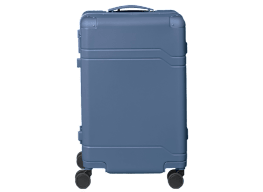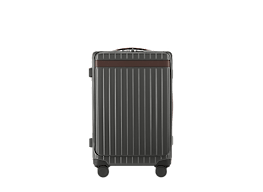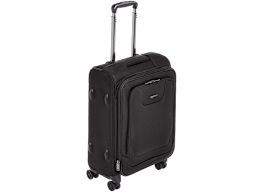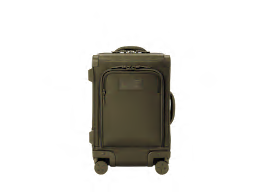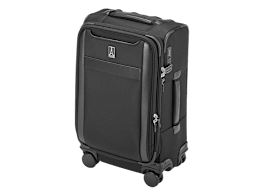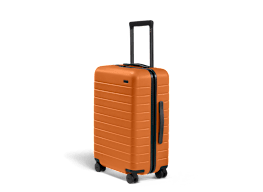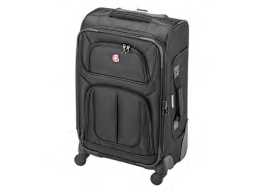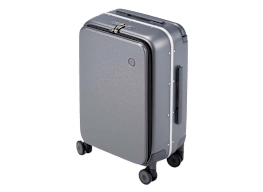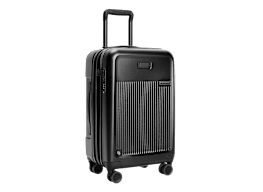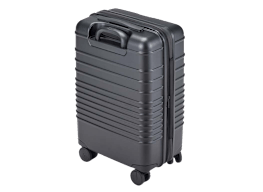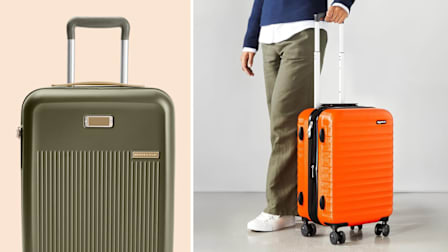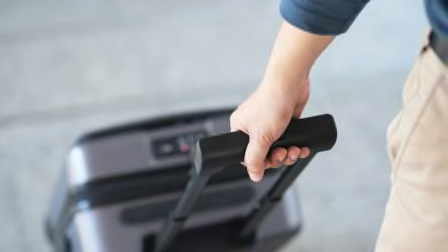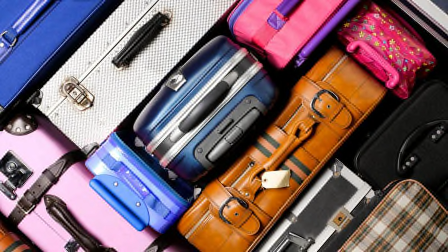7 Common Luggage Problems and How to Fix Them
Smart solutions to annoying travel hiccups and suitcase snags. Plus: The best sturdy, lightweight carry-ons from our tests.
When you shop through retailer links on our site, we may earn affiliate commissions. 100% of the fees we collect are used to support our nonprofit mission. Learn more.

Whether you’ll be hitting the road or taking to the skies this season, the right luggage can make your journey a lot smoother.
"A good suitcase should be easy to handle, durable, and secure," says Misha Kollontai, who oversees Consumer Reports’ luggage testing. But all too often, a lame wheel, a janky handle, or a too-heavy case can turn your roller bag into a literal drag.
If those frustrations sound familiar, it may be time for an upgrade. In our ratings of carry-on luggage, we’ve found the best rollers—one for as low as $55—that glide along effortlessly and hold up on long hauls.
Don’t need a new suitcase? Our experts also have solutions to common travel hiccups—from stuck zippers to lost luggage—so that you can get where you’re going with a lighter load, less stress, and your holiday spirit intact.
- 1. You Dread Hoisting Your Suitcase
- 2. Your Suitcase Is Hard to Roll
- 3. The Zippers Get Stuck & the Locks Are Tricky
- 4. You Can't Find Anything in Your Bag
- 5. You Can't Find Your Luggage
- 6. Suitcases Can Be So Pricey
- 7. How to Safely Stow a Suitcase
- Best Carry-on Luggage: Hard Shell Soft-Sided Suitcases
1. You Dread Hoisting Your Suitcase Up Stairs and Into Overhead Storage
A suitcase that’s too heavy is more than an inconvenience—it can cause you pain and even injury. While you can always ask for help along the way, flight attendants, for example, might not assist with lifting, so it’s important to be able to manage your bag yourself. Christine Childers, PhD, director of the Doctor of Physical Therapy Program at the University of Arizona’s Mel and Enid Zuckerman College of Public Health in Tucson, suggests trying this simple test before you leave home:
Pack your bag as you usually would, then place it on a sturdy, hip-height surface like a bed or table. Using both hands—one grabbing the top handle, the other grabbing the side handle—lower it to the floor, then lift it back up. If you feel unsteady or need to swing or jerk the bag to get it up, it’s probably too heavy to lift into an overhead bin or rack, Childers says.
Of course, you could take a few heavy items out of the bag. But it helps to start out with a light suitcase. Look for a carry-on made of a lightweight, durable material like a polycarbonate hard shell or ballistic nylon soft shell that weighs 7 pounds or less when empty. At just 5 pounds, the Travelpro Maxlite 5 21" Carry-On Spinner was the lightest bag we tested (the heaviest was 10 pounds). Even if you check your bag, that extra weight can still be a pain. Most national airlines add a fee—as much as $200—for bags weighing over 50 pounds.
2. Your Suitcase Is Hard to Roll
Even a lightweight bag can be difficult to maneuver in crowded airports, especially if it has only two wheels or a retractable handle that doesn’t extend to the right height. But many newer bags (including all of the ones in our luggage ratings) have four or eight "spinner" wheels that each swivel 360 degrees and have shock-absorbing suspension. "Bags with wheels at every corner are more stable," Kollontai says. "They also allow you to quickly change direction, roll around tight corners, and glide more smoothly up inclines."
3. The Zippers Always Get Stuck and the Locks Are Tricky
Look for YKK zippers, which have a reputation for moving effortlessly with less snagging. Case in point: The YKK zippers on the Briggs & Riley Sympatico Essential 22", Travelpro VersaPack+, and Monos Carry-On did well in our construction-quality testing.
To make zipping even easier, you can add accessible zipper pulls (about $15 for a pack of six) to the standard tabs on your bag. "Larger pulls reduce the need for fine motor control and require less finger strength," says Magdalena Cadet, MD, a rheumatologist at NYU Langone Health in New York City. Another option: Bag-repair specialists may be able to sew in magnetic clasps to replace standard fasteners.
As for those fiddly locks, they’re a good security addition, but many are small and tough to open and close quickly, adding to your stress when a Transportation Security Administration agent wants to look inside your bag or you need to retrieve an item. Buying a lock with larger dials can save you the headache of trying to correctly align tiny numbers, and it won’t cost you much. Many are under $20 online. Just make sure that any lock you buy is TSA-approved, which means that agents can open it with a universal key when needed. Otherwise, your lock could be forcibly opened and broken during a security check. Also consider TSA-approved fingerprint padlocks, which cost more than a dial lock—roughly $25 to $80 or more—but give you quick biometric access. Some "smart" options store multiple fingerprints so that several family members can use them, and some can be controlled by a mobile app, so you won’t need to memorize a combination. Some also allow you to track your bag via GPS. (See "You Can’t Find Your Luggage in a Sea of Look-Alikes," below.)
4. You Have to Dig Through Your Whole Bag to Find Anything
Some suitcases make staying organized a lot easier than others. There are two common designs: hard shell and soft sided. Hard-shell cases open like a book into two equal compartments with zippered mesh covers or straps that often double as compression systems. "This helps to keep items in place as well as nicely separated," Kollontai says. "For instance, clothes on one side and shoes and accessories on the other." Soft-sided models have just one main compartment, which means all of your items get stacked on top of each other, so it’s much harder to see things at a glance. Hard exteriors, typically made from impact-resistant polycarbonate, ABS plastic, or polypropylene, can also help protect fragile items. But they don’t have the same stretch as soft-sided bags, so look for an expandable hard shell if you tend to fill your bag to the brim.
If you prefer a soft-sided case, look for one made of ballistic nylon, a highly durable material, and extra storage features.
Higher-end models of both types may also have ports to charge electronics. The July and Tumi bags in our ratings have a built-in battery on the outside that you can plug a charger into. It can be removed if you’re forced to gate-check your carry-on. The Travelpro Platinum Elite Carry-On, a soft-sided case, has a dedicated side pocket with a USB cable, where you can stow and connect your own power bank to power the built-in charging port on the back of the bag.
Whichever style suits you best, look for a light-colored interior. This makes it easier to spot small, loose items that may fall to the bottom, like pill bottles. Some cases, like the July, come with dedicated laundry and organizer bags. Others, like the soft-sided Briggs & Riley Essential 22" Expandable Spinner, have dedicated compartments for hanging garments and zippered sections on the outside, good for keeping keys, tablets, and chargers within easy reach. For additional organization, our experts recommend using packing cubes.
5. You Can't Find Your Luggage in a Sea of Look-Alikes
It can be nearly impossible to pick your basic black bag out at baggage claim. To decrease the chance of a mix-up with other passengers, choose your next suitcase in an eye-catching color, like light blue, bright white, beige, red, pink, or green. Worried about scuffs on lighter-colored luggage? A magic eraser will lift them off. Monos throws one in with each suitcase purchase, and Away includes a melamine sponge with its hard-sided suitcases. Or consider a luggage cover with a bold color or design, which will make your bag distinctive and protect it from dirt, scuffs, and scratches. These easy-on, easy-off coverings are typically made of stretchy material for a snug fit, or clear PVC, kind of like a little zip-on raincoat with an opening for the handle. Samsonite and Béis are just two travel brands in our ratings that sell covers ($30 to $70). You can also purchase universal covers from retailers like Amazon and Walmart. Many are machine-washable.
Boosting visibility isn’t the only way to protect your luggage from getting lost—tech can help, too. Several U.S. carriers, including American, Delta, and United, will send you an alert through their smartphone app when your bag has been loaded and unloaded to give you peace of mind. Or you can try a luggage tracker. Tumi builds tracking services into its products (simply register your bag when you buy it to activate the service), but you can also purchase your own GPS tracker. Among the most popular are the Apple AirTag ($29), Eufy SmartTrack Link ($20), and Knog Scout Travel Smart Luggage Tag ($66), which has a rechargeable battery. (The Apple and Eufy trackers require buying replacement batteries about once a year.)
6. Suitcases Can Be So Pricey
High prices often reflect brand prestige, not how easy luggage is to travel with. For instance, Rimowa, a veteran luggage maker with a reputation for superior quality, charges more than $1,000 for an aluminum carry-on. But in our testing, its scores for usability and impact resistance landed it near the bottom of our ratings. On the other hand, both of the Amazon Basics suitcases we tested cost $80 or less and are recommended for their top-notch performance. So you can’t always judge a bag by its price.
Materials, features, and especially the warranty also have an impact on the cost. Cases made of aluminum, ballistic nylon, and leather are often more expensive than their polyester counterparts. And features like built-in trackers and charging ports boost the cost, too.
One benefit that can be worth paying more for is a generous warranty. Many luggage companies, such as Delsey, Samsonite, and Tumi, offer a limited five- to 10-year warranty that covers defects—like broken zippers, wheels, handles, or stitching—and malfunctions not caused by misuse. Airline damage and general wear and tear are usually excluded. A lifetime warranty, offered by brands such as Briggs & Riley and Monos, might add to the cost of a bag but covers defects and malfunctions for a much longer period of time, as well as airline damage. Before you buy, always check for warranty exclusions. Even brands that offer free in-house repairs under their warranty may charge you a fee to return a bag for service.
While it makes sense to spend more on a durable, lightweight suitcase with a lifetime warranty if you travel more than a few times a year, budget bags work well for infrequent or local trips.
7. How to Safely Stow a Suitcase
The more handles your bag has, the easier it is to lift. The best suitcases have a fixed handgrip on top and on one side, to provide leverage and control as you pick them up.
Step back and center yourself. One small step back from the overhead area on an airplane gives your arms space and helps maintain a neutral spine. That means keeping your back straight to reduce the risk of strain.
Get a solid grip. Grab the suitcase firmly using two handles—ideally one on the top and one on the side—for better control and stability as you lift.
Lift with your legs. Bend your knees, then straighten them, using leg muscles, not your back, to lift the case. Keep it close to your body.
Slide it in wheels first. Once it’s at chest height, angle the bag toward the bin, and guide it in by keeping one hand on the top handle and moving the other under the bag.
Best Hard-Shell Carry-on Luggage
These three hard-shell suitcases rate the highest among those we tested.
Best Soft-Sided Carry-on Luggage
If you’re looking for a soft-sided suitcase, you can’t go wrong with these three carry-ons.
Editor’s Note: This article also appeared in the November/December 2025 issue of Consumer Reports magazine.

















